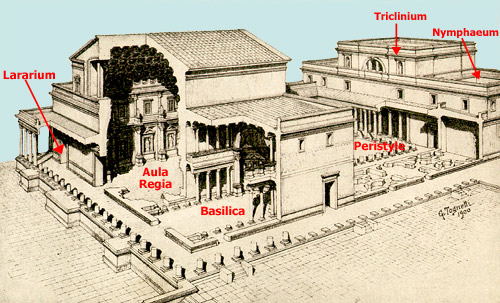
Here are the main entrances into the imperial palace. The portico running across the front of the Domus Flavia (as the public palace is often called) allowed access to the Basilica (right), the Aula Regia (center), and so-called the "Lararium" (left).
Built between 81 and 92 CE, the palace was designed for the emperor Domitian, younger son of the emperor Vespasian (Titus Flavius Vespasianus), by the architect Rabirius, who was famous for his grand scale and lavish use of water and different-colored marbles. This style suited Domitian, who didn't hesitate to flaunt his autocratic power (this relief portrays the goddess Roma and a bearded man representing the Senate welcoming the emperor; this bronze coin shows his equestrian statue); this short biography, however, argues that Domitian didn't entirely deserve the bad reputation given him by the ancient historians.
The poet Martial, who was born in Spain c. 40 CE and wrote over 1500 surviving poems, wrote a number of epigrams about this palace. The three poems below provide a revealing progression. The first two were written soon after the completion of the palace, while Domitian was still alive, and have been criticized for their fawning tone (however, Martial may have hidden a few barbs and stingers amid the exaggerations and extravagant flattery; read them carefully and see what you think). The third poem has an entirely different tone; it was written in 102 CE, after Domitian had been assassinated and the emperor Trajan had opened the palace to public view and dedicated its treasures to Jupiter.